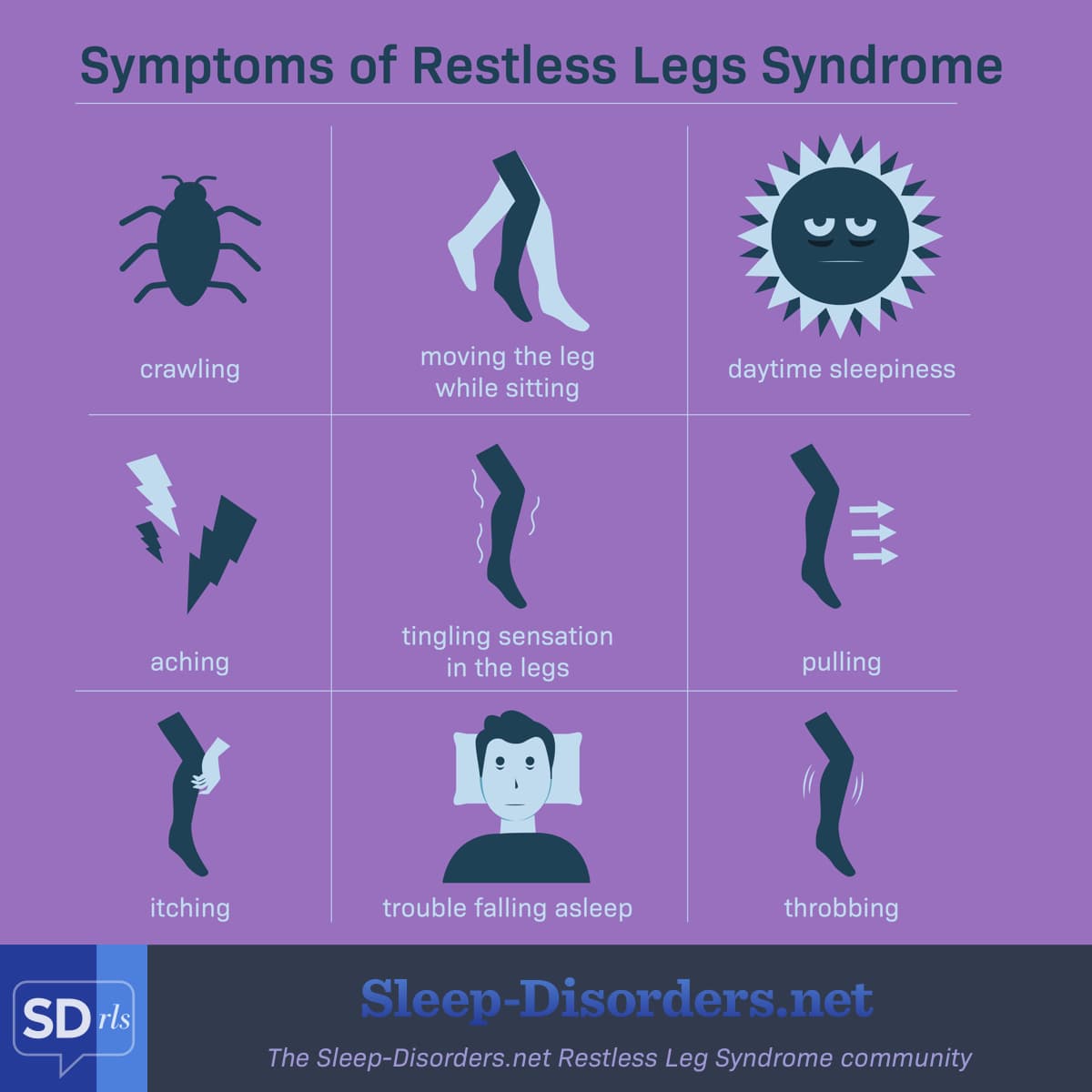Symptoms of Restless Legs Syndrome
Reviewed by: HU Medical Review Board | Last reviewed: June 2020 | Last updated: August 2021
Restless legs syndrome (RLS) is one of the most common sleep disorders, yet it is underdiagnosed. Studies estimate that between 5 and 15 percent of U.S. adults and 2 to 4 percent of children have RLS.1
Symptoms of restless legs syndrome can be hard to explain to other people. The most common symptoms include:1
- Aching, throbbing, itching, pulling, crawling, or tingling sensations in the legs
- Pacing, moving the legs while sitting, or tossing in bed to relieve the feelings
- Trouble falling asleep or staying asleep
- Daytime sleepiness and trouble concentrating due to lack of good sleep
Symptoms may come and go over time, or get worse when taking certain medicines. Lack of sleep, caffeine, and alcohol may also make RLS symptoms worse. RLS tends to get worse as people age.1-2
Figure 1. Symptoms of RLS
Itchy, twitchy legs
The most common symptom is a feeling of aching, throbbing, itching, pulling, crawling, burning, or tingling in the legs. Twitching, jerking, and the uncontrollable urge to move the legs or toes also occurs. A few people report feeling pain or a dull ache.1-2
These feelings most often occur in the late afternoon or evening when a person is sitting or resting. However, some people feel these feelings during the day when sitting still for a long time. It can be especially uncomfortable to sit through long meetings, movies, or plane rides. The discomfort usually gets better with movement.1,3
These sensations are most often felt in the lower legs, between the knees and ankles. But, the sensations may also be felt in the thighs or feet, and less often in the arms or head. Usually, the feelings happen in both legs equally, but sometimes only 1 leg is affected.2
Finding relief with movement
Many people with RLS find relief from their discomfort by moving the legs. They may walk around the house or ride a stationary bike at night to be able to sleep. People may have to get up several times in the night and walk around to find relief.1-3
During the day, they may kick or move their legs under the table at a meeting, or ask to stand and pace in the back of the room.
Periodic limb movement disorder
More than 80 percent of those with RLS also have periodic limb movement disorder (PLMD). RLS cannot be seen by others while PLMD can be seen by a bed partner or during a sleep study. With PLMD, the legs, and sometimes arms, twitch or jerk every 15 to 40 seconds, sometimes all night.4
Poor sleep
The tingling or kicking of RLS and PLMD can make it hard to fall asleep or stay asleep. This can lead to the same issues of people with insomnia: fatigue, daytime sleepiness, trouble concentrating, and poor moods. When moderate to severe RLS is left untreated, it can lead to a 20 percent drop in work productivity.1-2,4
When do symptoms begin?
People whose RLS runs in the family usually have symptoms before age 40 and find that their symptoms tend to get worse slowly with age. Between 40 and 90 percent of people with restless legs syndrome have at least 1 close relative with it.1,5
For people who did not inherit RLS, symptoms usually begin after age 45. For these people, symptoms tend to get worse quickly.
RLS is common during pregnancy but usually goes away after childbirth. RLS also occurs in people with kidney disease, anemia, Parkinson’s disease, fibromyalgia, rheumatoid arthritis, and while taking certain drugs.1-2
Rating how bad your symptoms are
Because RLS symptoms are often very individual, the International RLS Rating Scale helps doctors decide what type of treatment might be best. Reviewing this scale before talking with your doctor can also help you discuss your symptoms.3
How is restless legs syndrome diagnosed?
Most RLS is diagnosed by a doctor’s physical exam and medical history. There is no blood test for RLS, though your doctor may check your blood iron levels. A sleep study in a lab may help show whether you also have PLMD.1-3
